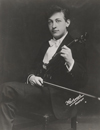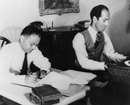All material found in the Press Releases section is provided by parties entirely independent of Musical America, which is not responsible for content.
Press Releases
Park Avenue Armory Making Space series presents 'Lenapehoking,' chamber music by Indigenous composer and musician Brent Michael Davids, May 30
New and pre-existing works consider the myth of the purchase of Manhattan from the Lenape perspective to mark the 400th anniversary of the origins of New Amsterdam
Presented in collaboration with the Lenape Center
New York, NY – Tuesday, April 8, 2025 – Park Avenue Armory’s Making Space Public Programming series continues on Friday, May 30th with Lenapehoking, an evening of chamber music by internationally celebrated Indigenous composer, musician, and educator Brent Michael Davids (Mohican/Munsee-Lenape). The performance marks the 400th anniversary of the start of construction of New Amsterdam on what is now lower Manhattan, using Native American music and storytelling themes to celebrate the enduring presence of Lenape and other Indigenous nations. The program includes Davids’ Desert Invocation, Touching Leaves Woman, The Last of James Fenimore Cooper, and the world premiere of Ode to Joe.
“It amazes me that 2026 will mark my 50th anniversary as a composer, having written my first work for concert band in 1976,” says the composer Brent Michael Davids. “Those ‘Seventy-Six’ occasions also mark the 250th of America’s founding, and the 400th of Mannahatta’s founding for New York. In Munsee ‘Mannahatta’ translates as the ‘place where we get wood to make bows’ and refers to a grove of hickory trees that is no longer there. Manhattan’s namesake is gone, but our original people are not. We are still here in Lenapehoking.”
“Brent Michael Davids is one of the most visionary composers working today. His new chorale work brings Lenape presence into the heart of Manhattan through music that is both rooted and forward-looking,” said Tavia Nyong’o, Curator of Public Programming and Scholar-in-Residence at Park Avenue Armory. “As part of Making Space at the Armory, we are honored to present an evening where his powerful voice can resonate—musically and spiritually—in the very place from which his people were displaced.”
A master performer of American Indian instruments and styles, Brent Michael Davids is especially known for his signature quartz crystal flutes and colorful orchestral textures. He incorporates these into his musical language in a variety of ways throughout this program engages audiences with Indigenous cultural expressions to envision decolonial futures through the power of music and narrative. Ode to Joe (Mahican lyrics, Wappinger theme) for chorus and Native American wood flute is dedicated to the lone Wappinger man “Joe” Two Trees and his friend Ted Kazimiroff, profiled by the author Ted Kazimiroff, Jr. in The Last Algonquin. The last of the Bronx’s Turtle Clan, “Joe” Two Trees lived in the wilds of the Bronx’s Pehlam Bay Park as recently as 1924, and his story was preserved and documented by the Kazimiroff family. Desert Invocation (2001), a solo work for quartz flute, uses picture notation to evoke a desert landscape, ultimately forming a bowing cactus with its notes. Touching Leaves Woman (Lenape lyrics, 2023), another picture notation work scored for voices and birdroars, honors Lenape teacher and herbalist Nora Thompson Dean (1907-1984), a beloved Indigenous cultural treasure who dedicated her life to preserving Lenape culture. Written for string quartet and narrator, The Last of James Fenimore Cooper (Mohican theme, 2001) spoofs Cooper’s book Last of the Mohicans, honoring the surviving Mohicans, the Stockbridge-Munsee Community, and to their perseverance, longevity, humor and unique way of life.
“The mission of Lenape Center establishes that the Lenape people still exist, live, and work today in Lenapehoking, our homeland and territory that still holds the spirits and voices of our Lenape ancestors,” says Hadrian Coumans, Co-Founder and Deputy Director of the Lenape Center. “We are honored to co-present a musical evening with the Armory’s public programming series, celebrating the enduring presence of Lenape in what is now lower Manhattan. We are the grandfathers and the peacemakers having survived hundreds of years of genocide. We welcome audiences to an evening with Brent Michael Davids, to the Armory, to Manhattan, to Lenapehoking.”
Held in the Armory’s historic period rooms and spaces, Making Space at the Armory is an insightful series of cutting-edge conversations, performances, and activations curated by writer and scholar?Tavia Nyong’o that provides a unique forum for bridging art and culture. Earlier this year, the Making Space series presented the largest North American installation of Yoko Ono’s Wish Tree to date, featuring 92 trees in the Wade Thompson Drill Hall, February 14th through 17th; the installation was accompanied by A Dream You Dream Together, a two-day symposium exploring Ono’s legacy in art, music, and peacemaking as well as tribute concerts by experimental electronic duo Matmos and a double bill by Alicia Hall Moran and Carl Hancock Rux. The 2025 Making Space season will also feature: Black Theater Advance, a collective conversation with Black theater makers that manifests the influence and importance of Black theaters across the country presented in collaboration with National Black Theatre on Saturday, September 6th; Caftan: Style as Liberation and Cultural Exchange, a panel discussion celebrating the legacy of Vogue editor and creative icon André Leon Talley led by thought leaders in the fashion industry that explores fashion’s role in self-expression, cultural preservation, and resistance on Sunday, September 28th; and additional dialogues with Drill Hall artists Anne Imhof, Trajal Harrell, Georg Friedrich Haas, and Philip Venables and Ted Huffman.
TICKETING
Tickets at $45 (plus fees) are available by phone through the Armory Box Office at (212) 933-5812, Monday through Friday from 10am to 6pm; and online at armoryonpark.org.
SPONSORSHIP
Making Space at the Armory is made possible with support from the Rockefeller Brothers Fund (RBF).
Citi and Bloomberg Philanthropies are Park Avenue Armory’s 2025 Season Sponsors. Leadership support for the Armory’s artistic programming has been generously provided by the Charina Endowment Fund, Donald A. Pels Charitable Trust, the Pinkerton Foundation, the Starr Foundation, and the Thompson Family Foundation.
Major support was also provided by the Emily Davie and Joseph S. Kornfeld Foundation, the Fan Fox and Leslie R. Samuels Foundation, The Harold and Mimi Steinberg Charitable Trust, the Horace W. Goldsmith Foundation, the Howard Gilman Foundation, the Marc Haas Foundation, The Shubert Foundation, the SHS Foundation, and Wescustogo Foundation. Additional support has been provided by the Armory’s Artistic Council. Public support is provided by the New York State Council on the Arts with the support of Governor Kathy Hochul and the New York State Legislature as well as the New York City Department of Cultural Affairs in partnership with the City Council under the leadership of Speaker Adrienne Adams.
ABOUT BRENT MICHAEL DAVIDS
Brent Michael Davids (Mohican/Munsee-Lenape) is a professional composer, and a music warrior for native equity and parity, especially in concert music where there is little indigenous influence. Davids places Native voices front and center. He originated and co-founded the award-winning Native American Composer Apprentice Project (NACAP), championing indigenous youth to compose their own written music. He uses indigenous instruments, including handmade quartz flutes, and pens performable notations that are themselves visual works of art. Davids is co-director of the Lenape Center in Manhattan, and is enrolled in the Stockbridge-Munsee Community. His composer career spans nearly five decades, with countless awards and commissions from America’s most celebrated organizations and ensembles.
International ensembles have premiered his works globally in Austria, Bermuda, Canada, England, France, Germany, Ireland, Italy, Japan, Luxembourg, Netherlands, Portugal, Russia, Scotland, South Korea, Spain, Sweden, and throughout the United States, including Carnegie Hall, Disney Concert Hall, Tanglewood Music Center’s Koussevitzky Shed and Ozawa Hall, Rothko Chapel, The Joyce Theater, Lincoln Center, Lincoln Center Out-Of-Doors, and The Kennedy Center. Davids is in high demand as an Educator and Consultant for Films, Television, Schools, Festivals, Seminars and Workshops. In 2006, the National Endowment for the Arts named Davids among the nation’s most celebrated choral composers in its project “American Masterpieces: Three Centuries of Artistic Genius.” And In 2015, the prestigious Indian Summer Music Festival awarded Davids its “Lifetime Achievement Award.”
Davids’ most recent project is “Requiem for America: Singing for the Invisible People.” This major work tackles the genocidal founding of America, giving voice to America’s Indigenous People. “Requiem” exposes a specific genocide in each state, juxtaposing genocidal texts from America’s founding against historical letters from American Indians themselves. In addition to the Western singers and orchestra, each performance will feature Indigenous singers recruited from local tribal communities. Once completed, it is hoped that “Requiem” will tour every state in the country.
ABOUT PUBLIC PROGRAMMING AT THE ARMORY
Park Avenue Armory’s Public Programming series brings diverse artists and cultural thought-leaders together for discussion and performance around the important issues of our time viewed through an artistic lens. Launched in 2017, the series encompasses a variety of programs including large-scale community events; multi-day symposia; intimate salons featuring performances, panels, and discussions; Artist Talks in relation to the Armory’s Wade Thompson Drill Hall programming; and other creative interventions.
Highlights from the Public Programming series include: Carrie Mae Weems’ 2017 event The Shape of Things and 2021 convening and concert series Land of Broken Dreams, whose participants included Elizabeth Alexander, Theaster Gates, Elizabeth Diller, Nona Hendryx, Somi, and Spike Lee, among others; a daylong Lenape Pow Wow and Standing Ground Symposium held in the Wade Thompson Drill Hall, the first congregation of Lenape Elders on Manhattan Island since the 1700s; “A New Vision for Justice in America” conversation series in collaboration with Common Justice, exploring new coalitions, insights, and ways of understanding question of justice and injustice in relation moderated by FLEXN Evolution creators Reggie (Regg Roc) Gray and director Peter Sellars; Culture in a Changing America Symposia exploring the role of art, creativity, and imagination in the social and political issues in American society today; the 2019 Black Artists Retreat hosted by Theaster Gates, which included public talks and performances, private sessions for the 300 attending artists, and a roller skating rink; 100 Years | 100 Women, a multiorganization commissioning project that invited 100 women artists and cultural creators to respond to women’s suffrage; a Queer Hip Hop Cypher, delving into the queer origins and aesthetics of hip hop with Astraea award-winning duo Krudxs Cubensi and author and scholar Dr. Shante Paradigm Smalls; the Archer Aymes Retrospective, exploring the legacy of emancipation through an immersive art installation curated by Carl Hancock Rux and featuring a concert performance by mezzo soprano Alicia Hall Moran and pianist Aaron Diehl, presented as one component of a three-part series commemorating Juneteenth in collaboration with Harlem Stage and Lincoln Center as part of the Festival of New York; legendary artist Nao Bustamante’s BLOOM, a cross-disciplinary investigation centered around the design of the vaginal speculum and its use in the exploitative and patriarchal history of the pelvic examination; Art at Water’s Edge, a symposium inspired by the work of director and scholar May Joseph on artistic invention in the face of climate change, including participants such as Whitney Biennale curator Adrienne Edwards, artist Kiyan Williams, Little Island landscape architect Signe Nielsen, eco-systems artist Michael Wang, and others; Symposium: Sound & Color – The Future of Race in Design, an interdisciplinary forum exploring how race matters in creative design for live performance hosted by lighting designer Jane Cox, playwright Branden Jacobs-Jenkins, set designer Mimi Lien, and sound designer and composer Mikaal Sulaiman and featuring collaborations with Design Action and Oregon Shakespeare Festival; Juke Joint, a two-day event spotlighting the history of the juke joint in Black American social history and its legacy in music and culture, including performances by Pamela Sneed and Stew; Hapo Na Zamani, a 1960s-style happening curated by Carl Hancock Rux with music direction by Vernon Reid, and presented in collaboration with Harlem Stage; Hidden Conversations, a celebration of Dr. Barbara Ann Teer with National Black Theatre; Corpus Delicti, a convening of artists, activists, and intellectuals imagines and enacts transgender art and music as a vehicle for dialogue across differences presented in collaboration with the NYC Trans Oral History Project; Guttural (Conducted Contact), a musical encapsulation of the African diaspora by multidisciplinary artist Richard Kennedy, closing The Radical Practice of Black Curation symposium in partnership with Princeton University; Antagonisms: A Gathering, a symposium investigating group dynamics led by playwright and essayist Claudia Rankine, renowned postcolonial theorist Homi Bhabha, and acclaimed cultural historian Saidiya Hartman, and opened by Guggenheim fellow and choreographer Shamel Pitts [Essence of] TOUCH OF RED; and Dorian Wood’s Canto de Todes / Song for All, a 12-hour durational chamber and electronic composition and installation mixing a genre-defying canon of folk, pop, and experimental music of Central and Latin America.
Notable Public Programming salons include: the Literature Salon hosted by Branden Jacobs-Jenkins, whose participants included Lynn Nottage, Suzan Lori-Parks, and Jeremy O. Harris; a Spoken Word Salon co-hosted with the Nuyorican Poets Cafe; a Film Salon featuring the works of immersive artist and film director Lynette Wallworth; “Museum as Sanctuary” led by installation artist and Artist-in-Residence Tania Bruguera, curated by Sonia Guiñansaca and CultureStrike, and featuring undocu-artists Julio Salgado and Emulsify; a Dance Salon presented in partnership with Dance Theater of Harlem, including New York City Ballet’s Wendy Whelan and choreographer Francesca Harper, among others; Captcha: Dancing, Data, Liberation, a salon exploring Black visual complexity and spirit, led by visionary artist Rashaad Newsome and featuring Saidiya V. Hartman, Kiyan Williams, Dazié Rustin Grego-Sykes, Ms.Boogie, Puma Camillê, and others; Seasons of Dance, a contemporary dance salon featuring conversations with “mother of contemporary African dance” Germaine Acogny, Tanztheater Wuppertal dancer Malou Airaudo, and dancers from The Rite of Spring / common ground[s] at the Armory; and Day for Night: A Salon on Art and Nightlife, an afternoon salon bringing together scholars, writers, artists, and nightlife makers to enlighten nightlife as an art form, and discover the ways social and performative dance have intertwined in recent years. presented in conjunction with R.O.S.E.
Artist Talks have featured esteemed artists, scholars, and thought leaders, such as: actor Bobby Cannavale; architects Jacques Herzog, Pierre de Meuron, and Elizabeth Diller; artist and composer Heiner Goebbels; choreographers Kyle Abraham, Reggie (Regg Roc) Gray, Bill T. Jones, Anne Teresa de Keersmaeker, and Justin Peck; composers Philip Miller, Thuthuka Sibisi, Tyshawn Sorey, Samy Moussa, and Alexandra Gardner; composer and director Michel van der Aa; composer, vocalist, and scholar Gelsey Bell; conductors Amandine Beyer and Matthias Pintscher; designer Peter Nigrini; directors Claus Guth, Robert Icke, Richard Jones, Sam Mendez, Satoshi Miyagi, Ariane Mnouchkine, Ben Powers, Peter Sellars, Yuval Sharon, Simon Stone, Ian Strasfogel, Ivo van Hove, and Alexander Zeldin; Juilliard president Damian Woetzel and Juilliard Provost and Dean Ara Guzelimian; musicians Helmut Deutsch, Nona Hendryx, Meredith Monk, Kathinka Pasveer, Miah Persson, and Davóne Tines; New Yorker editor David Remnick; James Nicola, Artistic Director of New York Theater Workshop; performance artists Marina Abramovic and Helga Davis; RoseLee Goldberg, Founding Director and Chief Curator of Performa; playwrights Branden Jacobs-Jenkins, Tony Kushner, Lynn Nottage, Jackie Sibblies Drury, and Anne Washburn; Dr. Augustus Casely Hayford, Director of the Smithsonian, National Museum of African Art; visual artists Nick Cave, William Kentridge, Julie Mehretu, Julian Rosefeldt, Hito Steyerl, and Ai Wei Wei; and writers and scholars Anne Bogart, Robert M. Dowling, Joseph Drew, Emily Greenwood, Hua Hsu, and Carol Martin.
ABOUT PARK AVENUE ARMORY
Part palace, part industrial shed, Park Avenue Armory supports unconventional works in the performing and visual arts that cannot be fully realized in a traditional proscenium theater, concert hall, or white wall gallery. With its soaring 55,000-square-foot Wade Thompson Drill Hall—reminiscent of 19th-century European train stations—and an array of exuberant period rooms, the Armory provides a platform for artists to push the boundaries of their practice, collaborate across disciplines, and create new work in dialogue with the historic building. Across its grand and intimate spaces, the Armory enables a diverse range of artists to create, students to explore, and audiences to experience epic, adventurous, relevant work that cannot be done elsewhere in New York.
The Armory both commissions and presents performances and installations in the grand Drill Hall and offers more intimate programming through its acclaimed Recital Series, which showcases musical talent from across the globe within the salon setting of the Board of Officers Room; its Artists Studio series curated by Jason Moran in the restored Veterans Room; Making Space at the Armory, a public programming series that brings together a discipline-spanning group of artists and cultural thought-leaders around the important issues of our time; and the Malkin Lecture Series that features presentations by scholars and writers on topics related to the Armory and its history. In addition, the Armory also has a year-round Artists-in-Residence program, providing space and support for artists to create new work and expand their practices.
The Armory’s creativity-based arts education programs provide access to the arts to thousands of students from underserved New York City public schools, engaging them with the institution’s artistic programming and outside-the-box creative processes. Through its education initiatives, the Armory provides access to all Drill Hall performances, workshops taught by Master Teaching Artists, and in-depth residencies that support the schools’ curriculum. Youth Corps, the Armory’s year-round paid internship program, begins in high school and continues into the critical post-high school years, providing interns with mentored employment, job training, and skill development, as well as a network of peers and mentors to support their individual college and career goals.
The Armory is undergoing a multi-phase renovation and restoration of its historic building led by architects Herzog & de Meuron, with Platt Byard Dovell White as Executive Architects.
###
Media Contacts
For more information or to request images, please contact:
Tom Trayer, tomtrayer@armoryonpark.org or (212) 933-5801
Allison Abbott, aabbott@armoryonpark.org or (212) 933-5834





 FEATURED JOBS
FEATURED JOBS

 RENT A PHOTO
RENT A PHOTO


